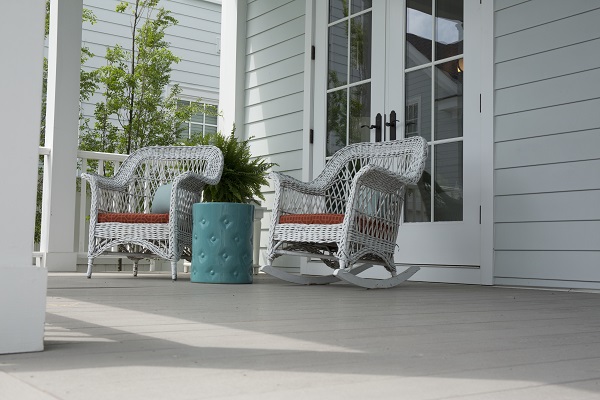How To Repair Hardie Board
Fiber Cement Siding Maintenance
Follow these recommendations for cobweb cement siding maintenance to help your home's siding stay cute for years to come.

![]()
Please follow these recommendations on caring for your James Hardie brand products. Damage to siding and trim arising from improper cleaning or maintenance may not be covered by the James Hardie warranty.
Outside House Washing Recommendations for Fiber Cement Siding and Trim
Follow these recommendations to clean the exterior of your home and to assistance maintain the beauty and value of your Hardie® siding.
- Wash down the exterior surfaces every six to 12 months with a garden hose to remove dirt and droppings, gently clean your siding with a soft brush or wet soft material in a side to side motion in the direction of the plank siding.
NOTE: Make clean by working minor sections at a time, starting from the top down to forestall dripping or streaking onto the cleaned surface area. - A low pressure water spray* and a soft medium bristle (not-metal) siding cleaning castor is virtually suitable for cleaning cobweb cement products.
NOTE: Acid and high pressure washing can damage the fiber cement surface and is non recommended. - Make clean James Hardie ColorPlus® products by using water and a soft brush or fabric. For stubborn dirt or stains, a mild detergent and a soft castor may be used.
Note: For pigment applied in the field, refer to the pigment manufacturer for washing and maintenance requirements.

Pictured clockwise from meridian left: Soft All Paint Castor, Horsehair Castor, Siding Brush, Bit Brush,
*Pressure Washer Warning:
Extra care should be taken when cleaning your siding and trim using a pressure washer. To minimize the chance of damaging your siding and trim use a broad fan tip, keep a minimum of 6 feet from the wall, and keep the pressure below 1500 psi.
General Fiber Cement Siding Maintenance
Maintaining the exterior of your home helps prevent water intrusion and is an of import part of sustaining the beauty and value of your domicile. The extent and nature of maintenance will depend on the design of your house, its geographic location, the amount of weather and sun exposure, and the landscaping near your house. Equally a guide, it is recommended that normal cobweb cement maintenance tasks and care include:
- Installing gutters and downspouts on your home—if they are non already present when you purchased the dwelling house.
- Cleaning out your gutters, blocked pipes, and overflows of any droppings, leaves, twigs and dirt.
- Keeping vegetation such as shrubs, bushes, and modest trees trimmed back and abroad from the dwelling and siding.
- Adjusting sprinkler systems so they do not excessively spray on siding or continuously soak the ground near your house.
- Avoiding direct contact with deicing salts, as these salts may prematurely harm the finished look of the siding. We recommend the apply of sand or gravel to manage snowy or icy surfaces near siding.
- Ensuring required external ground clearances (typically 6 in.) and drainage slopes are maintained.Annotation: Do not in fill landscaping up to the siding.
Re-Painting Siding
ColorPlus® Products
- ColorPlus® Touch-upward Kits can be used to encompass nicks, scrapes and nail holes that may occur over time.
- If the touch upward expanse is larger than the size of a dime, the use of ColorPlus® Touch-upwards Kit is Non recommended. Information technology is advised to replace the damage siding with a new section of ColorPlus® siding.
Primed Products
- If your Hardie® siding was originally painted later on information technology was installed on your habitation, then bank check the original paint manufacturer's recommendations for reapplication of pigment.
NOTE: Do not use stains or oil-based/alkyd paints on James Hardie brand products. For additional information on finishing James Hardie brand products, download Technical Bulletin #22 from here.

Cobweb Cement Siding Repair or Patching
- Re-applying caulking when it has begun to show signs of wear can help go on moisture from getting into the wall cavity. These areas include, merely non limited to, penetrations, flashings, plank and trim connections, and in some cases, betwixt plank joints.
Notation: James Hardie recommends the use of caulks and sealants that remain permanently flexible. Look for the words "permanently flexible" written clearly on the label or in the accompanying literature. For best results, use an Elastomeric Joint Sealant complying with ASTM C920 Grade NS, Grade 25 or college, or a Latex Joint Sealant complying with ASTM C834. Caulking/sealant must be applied in accordance with the caulking/sealant manufacturer'south written instructions or ASTM C1193. - Dents, chips, cracks and other modest surface damage in Hardie® siding and trim products can be filled with cementitious patching compound.

Source: https://www.jameshardie.com/product-support/resource-center/fiber-cement-siding-maintenance

0 Response to "How To Repair Hardie Board"
Post a Comment